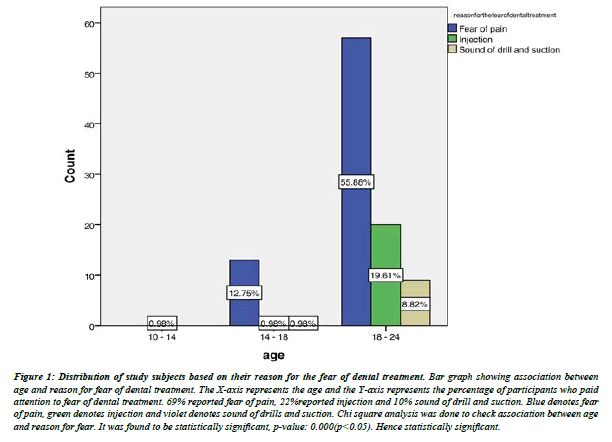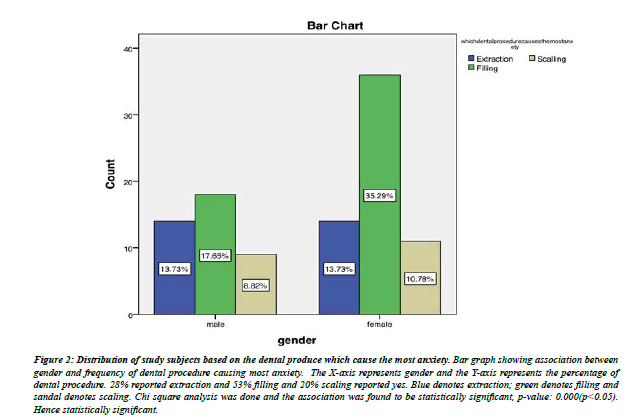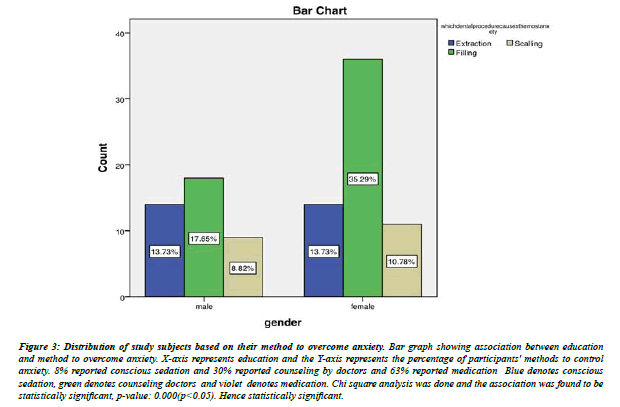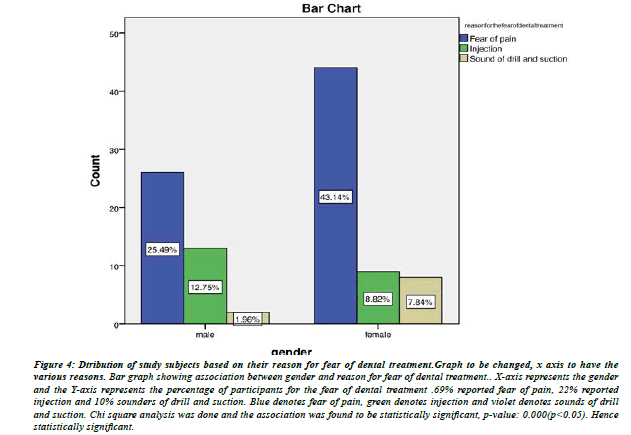Research Article - Journal Clinical Psychiatry and Cognitive Psychology (2022) Volume 6, Issue 3
Measurement of dental anxiety among young adolescents.
Gopika GG* and Sri Sakthi D
Department of Public Health Dentistry, Saveetha Dental College and Hospitals, Saveetha Institute of Medical and Technical Science, Saveetha University, Chennai
- Corresponding Author:
- Gopika GG
Department of Public Health Dentistry
Saveetha Dental College and Hospitals
Saveetha Institute of Medical and Technical Science
Saveetha University, Chennai
E-mail: 152001089.sdc@gmail.com
Received: 21-Apr-2022, Manuscript No. AACPCP-22-61387; Editor assigned: 25-Apr-2022, PreQC No. AACPCP-22-61387(PQ); Reviewed: 09-May-2022, QC No. AACPCP-22-61387; Revised: 11-May-2022, Manuscript No. AACPCP-22-61387(R); Published: 18-May-2022, DOI:10.35841/aacpcp-6.3.112
Citation: Gopika GG, Sakthi SD. Measurement of dental anxiety among young adolescents. J Clin Psychiatry Cog Psychol.2022;6(3):112
Abstract
Background: Fear of pain is a very common reason for avoiding the dentist. This fear usually comes from birth trauma and mostly from childhood experience. Hence it is important to understand the dental anxiety level of a patient who walks inside to the clinic to treat them comprehensively. Methodology: A total of 101 young adolescents visiting private dental hospitals participated in the study. A self-administered,10 item questionnaire was circulated among the patients. Only completely filled forms were taken in analysis. Results: Final analysis was done using responses from 101 study participants. Dental anxiety was found to be high. On the contrary, knowledge regarding preventing measures was only fair. Majority of the participants avoided dental treatment due to fear of pain (68.32%).The research suggested dental anxiety scales are valid measurement instruments for dental anxiety patients undergoing any painful procedure like filling (52.5%). Conclusion: This study throws a light on baseline knowledge regarding dental anxiety and its measurement, their attitude towards dental anxiety was very good. In order to transform the beliefs regarding dental anxiety into a fear, evidence based trials must be carried out.
Keywords
Dental anxiety, Measurement, Fear, Dentist, Young adolescents, Innovative analysis.
Introduction
Dental treatment will often cause dental anxiety in young and old alike. Dental anxiety is the anxiety in dental settings. Being anxious and fearful to visit the dentist can result in delaying or avoiding dental treatment. Dental anxiety can be associated with certain triggers such as needles, drills or the dental setting in general. The assessment of dental anxiety has encouraged the development of a variety of measures [1]. Fear and anxiety about dental treatment is a problem for many patients and can be a barrier to treatment: some patients avoid dentists altogether because of their extreme fears. Dentists can also become anxious when dealing with anxious patients: dentally anxious patients are more difficult to manage, take longer to treat, and are a major source of stress for the dental practitioner [2].
Individuals who treat themselves with kindness do not judge or criticize themselves harshly because self-judgment and selfcriticism would stem from the feeling of alienation and weaker relationships with others. An individual’s self-criticism is formed in two related processes [2,3]. Individuals who treat themselves with kindness do not judge or criticize themselves harshly because self-judgment and self-criticism would stem from the feeling of alienation and weaker relationships with others. An individual’s self-criticism is formed in two related processes [4].
Fear is a primary and powerful emotion which alerts us about imminent danger, with respect to an object or situation. When danger is recognized, the individual reacts with a set of behavioral and neurovegetative responses which are accompanied by a disagreeable sensation [4,5]. Special care for people with dental anxiety or phobia has a cost and research studies are needed to support reorganization of both dental teaching and dental services [6].
Our team has extensive knowledge and research experience that has translated into high quality publications [7-10]. This study was a self-administered survey planned to be conducted on the young adolescents visiting a private dental hospital in Chennai, measurement of dental anxiety among young adolescents.
Materials and Methods
Study design
A cross sectional questionnaire survey.
Study setting
Young adolescents visiting a private dental hospital in Chennai
Sample size
101 young adolescents visiting private dental hospital in Chennai
Sampling and scheduling
Owing to the nature of the study settings, a convenience sampling method was used. And the data was collected over a period of months.
Survey instrument
A pre-tested and validated questionnaire was used to measure the baseline knowledge, measurements of dental anxiety for the same.
Inclusion and exclusion criteria
All those who were willing to participate were included in the study. Those who were not willing and those who had language barrier in answering the english version of the questionnaire were excluded from the study
Ethical Clearance
Prior to the start of the study, ethical clearance was obtained from the institution ethical committee of Saveetha University
Statistical Analysis
The responses from the google sheet were transferred into excel and were then exported to SPSS software, version 25. Descriptive statistics was done using frequency and percentage. Inferential statistics was done using Chi square test. Interpretation was based on a p value less than 0.05, which was considered statistically significant. Comparisons were done between independent variables like age, gender, occupation and knowledge, attitude practice responses by the participants.
Results
A cross sectional questionnaire study containing a sample size of 10. Among 101 sample sizes, the study population contains 66.3% degree participants, 20.8% higher education participants, 12.9% professional participants. In our study 65.3% of them grade their anxiety level as moderate and 65.3% of them present dentist visits as regular checkup. 84.2% of the 18-24 age group people responded more and 54.5% visited the dentist two times so far. At the same time 68% were afraid of pain are the reason for their fear of dental treatment and 66.3% had lightheadedness physical manifestation of fear during dental treatment. In our study 52% filling dental procedures cause the most anxiety. 62.4% of people prefer medication to control anxiety (Figures 1-4).
Figure 1: Distribution of study subjects based on their reason for the fear of dental treatment. Bar graph showing association between age and reason for fear of dental treatment. The X-axis represents the age and the Y-axis represents the percentage of participants who paid attention to fear of dental treatment. 69% reported fear of pain, 22%reported injection and 10% sound of drill and suction. Blue denotes fear of pain, green denotes injection and violet denotes sound of drills and suction. Chi square analysis was done to check association between age and reason for fear. It was found to be statistically significant, p-value: 0.000(p<0.05). Hence statistically significant.
Figure 2: Distribution of study subjects based on the dental produce which cause the most anxiety. Bar graph showing association between gender and frequency of dental procedure causing most anxiety. The X-axis represents gender and the Y-axis represents the percentage of dental procedure. 28% reported extraction and 53% filling and 20% scaling reported yes. Blue denotes extraction; green denotes filling and sandal denotes scaling. Chi square analysis was done and the association was found to be statistically significant, p-value: 0.000(p<0.05). Hence statistically significant.
Figure 3: Distribution of study subjects based on their method to overcome anxiety. Bar graph showing association between education and method to overcome anxiety. X-axis represents education and the Y-axis represents the percentage of participants' methods to control anxiety. 8% reported conscious sedation and 30% reported counseling by doctors and 63% reported medication Blue denotes conscious sedation, green denotes counseling doctors and violet denotes medication. Chi square analysis was done and the association was found to be statistically significant, p-value: 0.000(p<0.05). Hence statistically significant.
Figure 4: Dtribution of study subjects based on their reason for fear of dental treatment.Graph to be changed, x axis to have the various reasons. Bar graph showing association between gender and reason for fear of dental treatment.. X-axis represents the gender and the Y-axis represents the percentage of participants for the fear of dental treatment .69% reported fear of pain, 22% reported injection and 10% sounders of drill and suction. Blue denotes fear of pain, green denotes injection and violet denotes sounds of drill and suction. Chi square analysis was done and the association was found to be statistically significant, p-value: 0.000(p< 0.05). Hence statistically significant..
Discussion
In our study, young adolescents grade their anxiety level as moderate 65.3% which is higher compared to Artur pitulaj et al where the feelings of a person using dental services stated that they were so anxious that they would sometimes break out in a sweat or almost feel physically sick. Neuroticism, as well as its cortical aspect, the tendency to react with fear, are predictors of anxiety in the situation of a visit to the dentist, although the correlation is weak [11].
68.3% were afraid of pain for their reason for fear of dental treatment which is higher compared to these results that agree with the concept of avoidance of care proposed by Locker. Other authors have associated these behaviours with previous negative experiences. It has also been reported that presence of pain during treatment and the negative attitude or unpleasant remarks of the dentist were correlated with dental anxiety [6].
52% think filling dental procedures caused the maximum anxiety which is higher compared to the levels of anxiety shown while sitting in the waiting area and chair before having dental treatment demonstrating the need for well-trained supporting staff to be aware of the anxious patients. However, memory of dental experiences is extremely powerful and painless dental experiences following bad experiences may not overcome perceived dental anxiety in the short term.
In our study 66.3% had lightheadedness caused during dental treatment which is higher compared to results obtained by other authors who evaluated the change in behavior of the young patient on subsequent visits to treatment in moderate sedation. Therefore, according to our experience, we believe that in these categories of Pedodontic patients a therapeutic approach in moderate sedation and the aid of the anesthesiologist is of considerable help and in some cases the only solution. In our study only a short period of data collection was used and the number of questions in the questionnaire was limited. Lack of dental staff and limitations in treatment projects were found. There will be possibilities of bias because some responders don't have access to the internet to participate in the online survey. Finally the online survey is limited. Further studies involve more efforts in informing the public to avoid the contamination in the dental offices [12-15].
Conclusion
Most of the young adolescents were fear of dental treatment due to the fear of pain 68.3% and they prefer medication to control the dental anxiety 62.4% reported that the various protective measures taken in the dental department gives them more confidence in the dental treatment and also some measures can be taken in further studies to treat the urgent cases with low risk.
Author Contributions
Gopika G G - Study design, Data collection, Data analysis, Manuscript writing.
Sri Sakthi D - Study concept, Data verification, Data analysis, Manuscript drafting and correction.
Acknowledgment
We thank all the participants and Saveetha Dental College for their support to conduct this study.
Conflict of Interest
The authors reported the conflict of interest while performing this study to be nil.
Source of Funding
The present project is supported/funded/sponsored by
Saveetha Institute of Medical and Technical Sciences, Saveetha Dental College and Hospitals, Saveetha University.
References
- Humphris GM, Freeman R, Campbell J, et al. Further evidence for the reliability and validity of the Modified Dental Anxiety Scale. Int. Dent. J.2000;1;50(6):367-70.
- Ilgüy D, Ilgüy M, Dinçer S, et al. Reliability and validity of the Modified Dental Anxiety Scale in Turkish patients. Int. J. Med. Res.2005;33(2):252-9.
- Deniz M, Kesici ?, Sümer AS. The validity and reliability of the Turkish version of the Self-Compassion Scale. Soc Behav Pers. 2008;1;36(9):1151-60.
- Mongrain M, Vettese LC, Shuster B, et al. Perceptual biases, affect, and behavior in the relationships of dependents and self-critics. J. Pers. Soc. Psychol. 1998;75(1):230.
- Muza R, Muza P. Ansiedad en un servicio de emergencia dental. Horizonte de Enfermería. 2008;19(1):23-8.
- Nicolas E, Collado V, Faulks D, et al. A national cross-sectional survey of dental anxiety in the French adult population. BMC oral health. 2007;(1):1-7.
- Samuel SR. Can 5-year-olds sensibly self-report the impact of developmental enamel defects on their quality of life? Int. J. Paediatr. Dent.2020;31(2):285-6.
- Kuduruthullah S, Al Shayeb M, Elkaseh A, et al. Impact of pain, psychological-distress, SARS-CoV2 fear on adults’ OHRQOL during COVID-19 pandemic. Saudi J Biol Sci. 2020;27.
- Samuel SR, Kuduruthullah S, Khair AM, et al, Varma SR. Dental pain, parental SARS?CoV?2 fear and distress on quality of life of 2 to 6 year?old children during COVID?19. Int.J.Paediatr. Dent. 2021;31(3):436-41.
- Samuel SR, Acharya S, Rao JC. School Interventions–based Prevention of Early?Childhood Caries among 3–5?year?old children from very low socioeconomic status: Two?year randomized trial. J. Public Health Dent. 2020;80(1):51-60..
- Vikneshan M, Saravanakumar R, Mangaiyarkarasi R, et al. Algal biomass as a source for novel oral nano-antimicrobial agent. Saudi J Biol Sci. 2020;27(12):3753-8..
- Chellapa LR, Shanmugam R, Indiran MA, et al. Biogenic nanoselenium synthesis, its antimicrobial, antioxidant activity and toxicity. Bioinspired, Biomim. Nanobiomaterials. 2020;9(3):184-9..
- Samuel SR, Mathew MG, Suresh SG, et al. Pediatric dental emergency management and parental treatment preferences during COVID-19 pandemic as compared to 2019. Saudi J Biol Sci. 2021;28(4):2591-7..
- Barma MD, Muthupandiyan I, Samuel SR, et al. Inhibition of Streptococcus mutans, antioxidant property and cytotoxicity of novel nano-zinc oxide varnish. Arch. Oral Biol. 2021;126:105132..
- Muthukrishnan L. Multidrug resistant tuberculosis–Diagnostic challenges and its conquering by nanotechnology approach–An overview. Chemico-Biological Interactions. 2021;337:109397.
Indexed at, Google Scholar, Cross Ref
Indexed at, Google Scholar, Cross Ref
Indexed at, Google Scholar, Cross Ref
Indexed at, Google Scholar, Cross Ref
Indexed at, Google Scholar, Cross Ref
Indexed at, Google Scholar , Cross Ref
Indexed at, Google Scholar, Cross Ref
Indexed at, Google Scholar, Cross Ref
Indexed at, Google Scholar, Cross Ref
Indexed at, Google Scholar, Cross Ref



